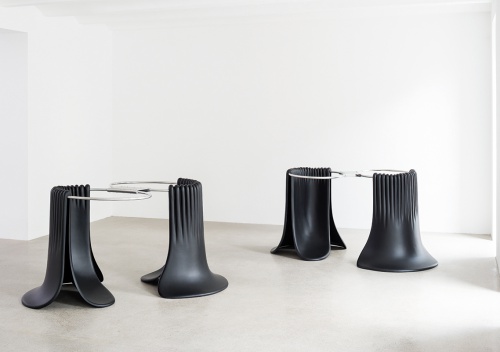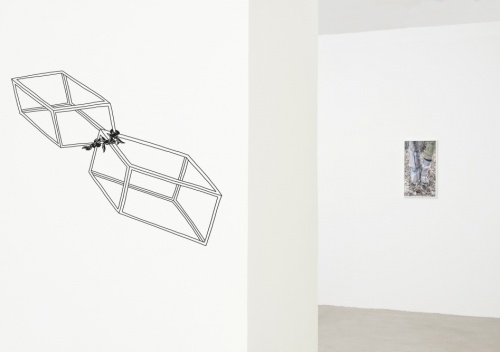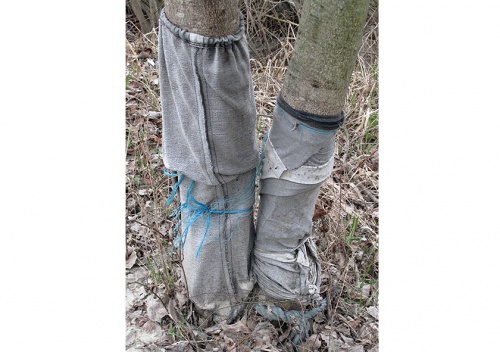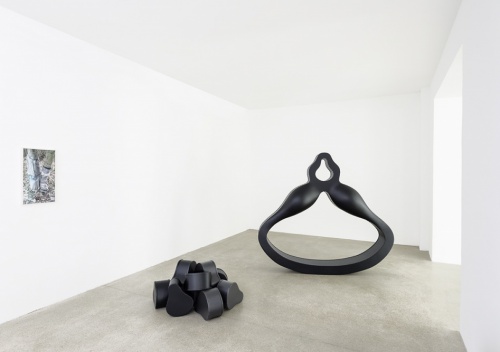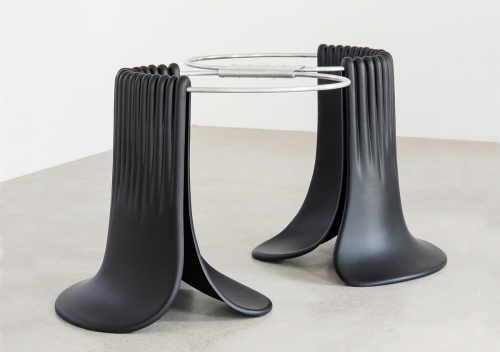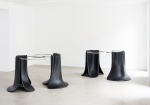 Let’s dance, 2014, fibreglass, aluminium each 120 x 110 x 250 cm, Installation view, 2014
Let’s dance, 2014, fibreglass, aluminium each 120 x 110 x 250 cm, Installation view, 2014
Photo: Jorit Aust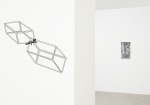 O.T., 2014, taped drawing plotted,120 x 120 cm; O.T. (Alberner Hafen), Installation view, 2014
O.T., 2014, taped drawing plotted,120 x 120 cm; O.T. (Alberner Hafen), Installation view, 2014
Photo: Jorit Aust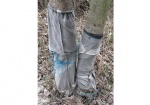 O.T. (Alberner Hafen), 2013, Fine Art Print, framed, 60 x 33 cm
O.T. (Alberner Hafen), 2013, Fine Art Print, framed, 60 x 33 cm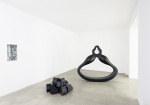 O.T. (Alberner Hafen) (left), Ohne Titel (right),Installation view, 2014
O.T. (Alberner Hafen) (left), Ohne Titel (right),Installation view, 2014
Photo: Jorit Aust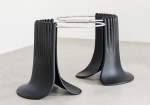 Let’s dance, 2014, fibreglass, aluminium 120 x 110 x 250 cm
Let’s dance, 2014, fibreglass, aluminium 120 x 110 x 250 cm
Photo: Jorit Aust
Subliminal
,Installation view, 2014
Thomas Mießgang
Let’s dance! Put on your red shoes n dance the blues. Let’s sway, sway through the crowd to an empty space.
Yet could they dance at all, these black ribbed entities which look like oil puddles distorted into the perpendicular? Siamese cakewalk? English waltz behind bars? Rock ‘n’ roll welded together in a morganatic marriage? Polyester and steel, apparently heavy and yet nevertheless easy to shift with a slight movement of the arm? The massive appearance of liquid transformed into a solid state of matter contrasts with an evidently thin-walled nature, suggested volume and the visibility of an inner life, as may be discerned from the resultant manufacturing. Moreover, the connection of the two “bodies” by means of tightly screwed components, reminiscent of handcuffs, evokes a relationship pattern that has something violent about it: whiplash girlchild in the dark.
It is a design principle which always seems to recur in the work of Julie Hayward. Even in the early works, such as catch me if you can, pooped or Aequilibrium, the invented forms are laced up or tied down or fastened together with a clip. In general, the principle of duality, in which two elements manifest as a body together with its reflection, or accompanied by its shadow, frequently makes an appearance as an artistic agent.
Hayward’s biomorphic sculptures are often navigated in a certain intellectual direction by means of the titles they are given, although this may lead to a dark, unlit non-place at the end of the street. Nothing is final about these works, which play with the dialectics of mimesis and difference. They sometimes seem like nightmarish projections from the subconscious, then again like little building blocks or gyroscopic figures that have been so enlarged as to become over-dimensional. Phainomena, which can be seen with the eye, yet equally noumena, which can be recognised by the mind. Toys for an imagination that is liberated from the chains of convention.
The outcome of the second large-scale work in the “Subliminal” exhibition is even more open as far as interpretation is concerned – for those who seek to force an interpretation upon it: This time it is Ohne Titel, i. e. untitled. An irregularly round geometrical form which tapers upwards at the end and brings forth a second, smaller, empty space. In front of it is a pile of black elements, which look like the carelessly scattered pieces of a puzzle. It makes one think of an oversize mouth which has spat out its teeth in non-rational repulsion. Or of faces which have been removed and have left behind them a negative form: black holes, anti-matter, the stability of the unstable. The parts of the sculpture have been connected/riveted to one another in such a way that the viewer can still recognise their modular character. Although, at first glance, it seems ponderous, suggesting heaviness, nevertheless the unavoidable idea it gives rise to is that the form is hollow inside and that a kind of trompe de l´esprit has been staged here.
The great sculptural morphogeneses in the exhibition are reflected by a few smaller works, which take up motifs and vary within the framework of their respectively chosen form of artistic representation. The sole photograph shows two trees, which have been wrapped in cloth in order to protect them from mooring boats. Standing leg and free leg, ballet stockings that have slipped down, an imaginary/imagined body which is about to leave a position of stability in order to surrender itself to the swirl of the dance. If you say run, I run with you. Let’s dance. Like all Julie Hayward’s photographs, O.T. 2014 belongs to the complex of “found installations and objects” discovered on extended walks, which first become defined as such through the act of documentation. The drawing O.T. 2013, on the other hand, which serves as a kind of prelude to the exhibition, anticipates the binary principle of Let’s dance, filtered through the artist’s sensitivity and creative idiosyncrasy, and imprints another ontological signature upon it: two open boxes which are only defined by their outlines, are connected to each other by a textile-like material. The reductionist aesthetics of the drawing are a variation of the formal principles that Julie Hayward has already put to the test in earlier works (Transformator, TV-Baby): the connection between biomorphic shapes, rounded forms and soft lines, and the straight-lined contours of a clearly defined geometric body which stands for structure and rational clarity.
Through the loose connection between the boxes, and despite a homologous accentuation of the principle of duality, the drawing creates a certain contrast to the relentless stranglehold of those objects that are less clearly stratified, from the point of view of both form and content, which in Let’s dance evoke the dizziness of the dance and the ecstasy of spinning. “Dance, drunkenness, toxic excesses, self-mutilation etc. are series of actions that proceed from the outside to the inside”, writes Arnold Gehlen, “and the desired excess and hypertension of affectivity and sensitivity in them attains the highest state because the dissipated restrictive energies enter into the dynamism, thus leading to a liberation and unburdening of the human being, which is experienced as enjoyable.”
Some of Julie Hayward’s sculptures, which have the effect of shock-frozen manifestations of these kinds of kinetic promises, are to be found in the film work Suck, with which the exhibition closes, translated into that mode of being which is enshrined as an entelechial principle: animation techniques make the objects run, moving in space like monsters from primeval worlds and trying to find a place to hold onto with their tentacles. Let’s dance, for fear your grace should fall.
In this way, the exhibition “Subliminal” gives us a panoramic view of the art of Julie Hayward within the smallest possible space. It indicates the way that leads from drawing to three-dimensionality, it becomes intoxicated with the paradoxes of stasis and hypertension, which subliminally vibrate in the immobilised artefact. It raises questions about similarity and difference, about ontological stability and transcendental homelessness.
In this context, subliminal means that stimuli are activated which do not cross the threshold of awareness, that beneath the superficial layer which is accessible to the eye and to the tentative grasp, other, more cryptic energies are at work. On a number of occasions, the artist has described the work processes that underlie the invention of her forms: the works are developed from drawing, during which she tries to switch off the controlling aspects of the ego as far as possible and let herself be led by her hand: “That always happens on an A4 format with black fineliner, which does not scratch and so distract, and has a constant thickness of line. The format offers something to hang on to in this state of limbo.”
It is an archaeological process, which excavates forms that were previously locked in an existential paradigm and could not be controlled directly or indirectly. Although Hayward emphasises that these configurations should not to be deciphered as dream stories, there nevertheless seems to be a kind of “infinite-dimensional dream logic”, as Hermann Broch calls it, at work, which is able to drive forward these sculptural excavations between objectivism and abstraction, between mimesis and loss of form, between geometrical organisation and distortion. It is an aesthetics of ciphers and of ambivalent symbols, which often first surface in the drawings and then also infect the three-dimensional works. Puddles, fluids, thick slime – in the polyester alloys of the artistic work, liquid manifestations from a world of phenomena become static determinations, which inaugurate a game without borders involving the dialectics of anorganic presence and elan vital. In the work I wanna go home, a figure standing obliquely, whose contours are reminiscent of an over-dimensional grenade launcher, seems to be stuck in a puddle: a “launching pad for the soul”, the transcendental filling material of which has already been shot into orbit, while the covering had to remain behind in accordance with the laws of gravity. It is a matter of the presence of emptiness and the absence of ontological compression; a matter of an artistic claim which places the nefariously unworldly (Toni Negri) in a constantly permutating relationship of tension with the energetic karma of a self-transcendent existence. In o.T. on the other hand, the form of the form is the form which produces new formlessness: “I’m fixing a hole where the rain gets in. And stops my mind from wandering.” (The Beatles)
Catch me if you can, where likewise a puddle is to be seen, stretches like a flexible epidermis full of surface tension, in which something living – or: something undead? – seems to escape control by aspects of the ego, or by the super-ego guardians of the grail. Perhaps an artistic visualisation of the real, in line with Lacan? That which cannot be imagined or symbolised, which exists beyond normal reality, and is suppressed because regarded as threat to it? In any case, it is a stratum basale, a basal cell layer, in which artistic cell divisions of all kinds can take place: the Horror, the Horror.
There is one gene strand which runs like a fertile artistic programme through almost all Julie Hayward’s work: those subliminal structures, which act secretly as the background radiation of existential actualisations, guiding relations as subliminal feelings and determining the mainstay of being in the world. It is a matter of the unresolved and unresolvable relationship of conflict between transcendental homelessness and that “ontological security”, as Anthony Giddens calls it: the correspondence between routine actions and the actors’ need for security. In this tense zone of being, where the dreams have not yet taken on forms that can be narrated, and the contradictions of the human soul – which, as Hermann Broch says, contains “Good as well as evil, black as well as white, orgy as well as asceticism” – are revealed, Julie Hayward dares to take steps into the unknown and attempts to lead that which has long been intuited out into the visible field.
Elsewhere, Broch wrote that through a work of art people are given a way to get closer to a logic that lies deep inside them: forms, colours, images and structures affect, illuminate and complement one another. This is the only way to be able to show “how the highest intellectual aims of human beings are directly linked to the hardly suspected existential foundations, and can develop from these purely instinctive roots into a form of direct growth.”
It may be this dream logic that takes effect in the existential foundations of Julie Hayward’s artistic energy, it may be an individually appropriated variation of the automatic writing of the Surrealists, a kind of dessin automatique, or the aesthetic practice of endowing the process-oriented acts of the unconscious with a visual form: what is essential is that, at the existential non-place between memory and forgetfulness, a very subjective formal idiosyncrasy emerges, which is nevertheless allowed to claim liability and the capacity to connect and mediate between being and appearance. “We can only perceive the world as it appears to us,” writes Christoph Türcke in “Philosophy of Dreams”. “However, appearances are always simply an external facet: appearances of something that does not itself appear. What is concealed by appearances, what can only be comprehended ‘speculatively’, i. e. by thinking, not through the senses, is then in philosophy called ‘being’, ‘substance’ or ‘the thing in itself’.” In Julie Hayward’s art, one believes, at least, that one is getting a sense of this “thing in itself”, experiencing a butterfly wing’s flutter of “substance”. Put on your red shoes. Let’s dance!
Let’s dance! Put on your red shoes n dance the blues. Let’s sway, sway through the crowd to an empty space.
Yet could they dance at all, these black ribbed entities which look like oil puddles distorted into the perpendicular? Siamese cakewalk? English waltz behind bars? Rock ‘n’ roll welded together in a morganatic marriage? Polyester and steel, apparently heavy and yet nevertheless easy to shift with a slight movement of the arm? The massive appearance of liquid transformed into a solid state of matter contrasts with an evidently thin-walled nature, suggested volume and the visibility of an inner life, as may be discerned from the resultant manufacturing. Moreover, the connection of the two “bodies” by means of tightly screwed components, reminiscent of handcuffs, evokes a relationship pattern that has something violent about it: whiplash girlchild in the dark.
It is a design principle which always seems to recur in the work of Julie Hayward. Even in the early works, such as catch me if you can, pooped or Aequilibrium, the invented forms are laced up or tied down or fastened together with a clip. In general, the principle of duality, in which two elements manifest as a body together with its reflection, or accompanied by its shadow, frequently makes an appearance as an artistic agent.
Hayward’s biomorphic sculptures are often navigated in a certain intellectual direction by means of the titles they are given, although this may lead to a dark, unlit non-place at the end of the street. Nothing is final about these works, which play with the dialectics of mimesis and difference. They sometimes seem like nightmarish projections from the subconscious, then again like little building blocks or gyroscopic figures that have been so enlarged as to become over-dimensional. Phainomena, which can be seen with the eye, yet equally noumena, which can be recognised by the mind. Toys for an imagination that is liberated from the chains of convention.
The outcome of the second large-scale work in the “Subliminal” exhibition is even more open as far as interpretation is concerned – for those who seek to force an interpretation upon it: This time it is Ohne Titel, i. e. untitled. An irregularly round geometrical form which tapers upwards at the end and brings forth a second, smaller, empty space. In front of it is a pile of black elements, which look like the carelessly scattered pieces of a puzzle. It makes one think of an oversize mouth which has spat out its teeth in non-rational repulsion. Or of faces which have been removed and have left behind them a negative form: black holes, anti-matter, the stability of the unstable. The parts of the sculpture have been connected/riveted to one another in such a way that the viewer can still recognise their modular character. Although, at first glance, it seems ponderous, suggesting heaviness, nevertheless the unavoidable idea it gives rise to is that the form is hollow inside and that a kind of trompe de l´esprit has been staged here.
The great sculptural morphogeneses in the exhibition are reflected by a few smaller works, which take up motifs and vary within the framework of their respectively chosen form of artistic representation. The sole photograph shows two trees, which have been wrapped in cloth in order to protect them from mooring boats. Standing leg and free leg, ballet stockings that have slipped down, an imaginary/imagined body which is about to leave a position of stability in order to surrender itself to the swirl of the dance. If you say run, I run with you. Let’s dance. Like all Julie Hayward’s photographs, O.T. 2014 belongs to the complex of “found installations and objects” discovered on extended walks, which first become defined as such through the act of documentation. The drawing O.T. 2013, on the other hand, which serves as a kind of prelude to the exhibition, anticipates the binary principle of Let’s dance, filtered through the artist’s sensitivity and creative idiosyncrasy, and imprints another ontological signature upon it: two open boxes which are only defined by their outlines, are connected to each other by a textile-like material. The reductionist aesthetics of the drawing are a variation of the formal principles that Julie Hayward has already put to the test in earlier works (Transformator, TV-Baby): the connection between biomorphic shapes, rounded forms and soft lines, and the straight-lined contours of a clearly defined geometric body which stands for structure and rational clarity.
Through the loose connection between the boxes, and despite a homologous accentuation of the principle of duality, the drawing creates a certain contrast to the relentless stranglehold of those objects that are less clearly stratified, from the point of view of both form and content, which in Let’s dance evoke the dizziness of the dance and the ecstasy of spinning. “Dance, drunkenness, toxic excesses, self-mutilation etc. are series of actions that proceed from the outside to the inside”, writes Arnold Gehlen, “and the desired excess and hypertension of affectivity and sensitivity in them attains the highest state because the dissipated restrictive energies enter into the dynamism, thus leading to a liberation and unburdening of the human being, which is experienced as enjoyable.”
Some of Julie Hayward’s sculptures, which have the effect of shock-frozen manifestations of these kinds of kinetic promises, are to be found in the film work Suck, with which the exhibition closes, translated into that mode of being which is enshrined as an entelechial principle: animation techniques make the objects run, moving in space like monsters from primeval worlds and trying to find a place to hold onto with their tentacles. Let’s dance, for fear your grace should fall.
In this way, the exhibition “Subliminal” gives us a panoramic view of the art of Julie Hayward within the smallest possible space. It indicates the way that leads from drawing to three-dimensionality, it becomes intoxicated with the paradoxes of stasis and hypertension, which subliminally vibrate in the immobilised artefact. It raises questions about similarity and difference, about ontological stability and transcendental homelessness.
In this context, subliminal means that stimuli are activated which do not cross the threshold of awareness, that beneath the superficial layer which is accessible to the eye and to the tentative grasp, other, more cryptic energies are at work. On a number of occasions, the artist has described the work processes that underlie the invention of her forms: the works are developed from drawing, during which she tries to switch off the controlling aspects of the ego as far as possible and let herself be led by her hand: “That always happens on an A4 format with black fineliner, which does not scratch and so distract, and has a constant thickness of line. The format offers something to hang on to in this state of limbo.”
It is an archaeological process, which excavates forms that were previously locked in an existential paradigm and could not be controlled directly or indirectly. Although Hayward emphasises that these configurations should not to be deciphered as dream stories, there nevertheless seems to be a kind of “infinite-dimensional dream logic”, as Hermann Broch calls it, at work, which is able to drive forward these sculptural excavations between objectivism and abstraction, between mimesis and loss of form, between geometrical organisation and distortion. It is an aesthetics of ciphers and of ambivalent symbols, which often first surface in the drawings and then also infect the three-dimensional works. Puddles, fluids, thick slime – in the polyester alloys of the artistic work, liquid manifestations from a world of phenomena become static determinations, which inaugurate a game without borders involving the dialectics of anorganic presence and elan vital. In the work I wanna go home, a figure standing obliquely, whose contours are reminiscent of an over-dimensional grenade launcher, seems to be stuck in a puddle: a “launching pad for the soul”, the transcendental filling material of which has already been shot into orbit, while the covering had to remain behind in accordance with the laws of gravity. It is a matter of the presence of emptiness and the absence of ontological compression; a matter of an artistic claim which places the nefariously unworldly (Toni Negri) in a constantly permutating relationship of tension with the energetic karma of a self-transcendent existence. In o.T. on the other hand, the form of the form is the form which produces new formlessness: “I’m fixing a hole where the rain gets in. And stops my mind from wandering.” (The Beatles)
Catch me if you can, where likewise a puddle is to be seen, stretches like a flexible epidermis full of surface tension, in which something living – or: something undead? – seems to escape control by aspects of the ego, or by the super-ego guardians of the grail. Perhaps an artistic visualisation of the real, in line with Lacan? That which cannot be imagined or symbolised, which exists beyond normal reality, and is suppressed because regarded as threat to it? In any case, it is a stratum basale, a basal cell layer, in which artistic cell divisions of all kinds can take place: the Horror, the Horror.
There is one gene strand which runs like a fertile artistic programme through almost all Julie Hayward’s work: those subliminal structures, which act secretly as the background radiation of existential actualisations, guiding relations as subliminal feelings and determining the mainstay of being in the world. It is a matter of the unresolved and unresolvable relationship of conflict between transcendental homelessness and that “ontological security”, as Anthony Giddens calls it: the correspondence between routine actions and the actors’ need for security. In this tense zone of being, where the dreams have not yet taken on forms that can be narrated, and the contradictions of the human soul – which, as Hermann Broch says, contains “Good as well as evil, black as well as white, orgy as well as asceticism” – are revealed, Julie Hayward dares to take steps into the unknown and attempts to lead that which has long been intuited out into the visible field.
Elsewhere, Broch wrote that through a work of art people are given a way to get closer to a logic that lies deep inside them: forms, colours, images and structures affect, illuminate and complement one another. This is the only way to be able to show “how the highest intellectual aims of human beings are directly linked to the hardly suspected existential foundations, and can develop from these purely instinctive roots into a form of direct growth.”
It may be this dream logic that takes effect in the existential foundations of Julie Hayward’s artistic energy, it may be an individually appropriated variation of the automatic writing of the Surrealists, a kind of dessin automatique, or the aesthetic practice of endowing the process-oriented acts of the unconscious with a visual form: what is essential is that, at the existential non-place between memory and forgetfulness, a very subjective formal idiosyncrasy emerges, which is nevertheless allowed to claim liability and the capacity to connect and mediate between being and appearance. “We can only perceive the world as it appears to us,” writes Christoph Türcke in “Philosophy of Dreams”. “However, appearances are always simply an external facet: appearances of something that does not itself appear. What is concealed by appearances, what can only be comprehended ‘speculatively’, i. e. by thinking, not through the senses, is then in philosophy called ‘being’, ‘substance’ or ‘the thing in itself’.” In Julie Hayward’s art, one believes, at least, that one is getting a sense of this “thing in itself”, experiencing a butterfly wing’s flutter of “substance”. Put on your red shoes. Let’s dance!
